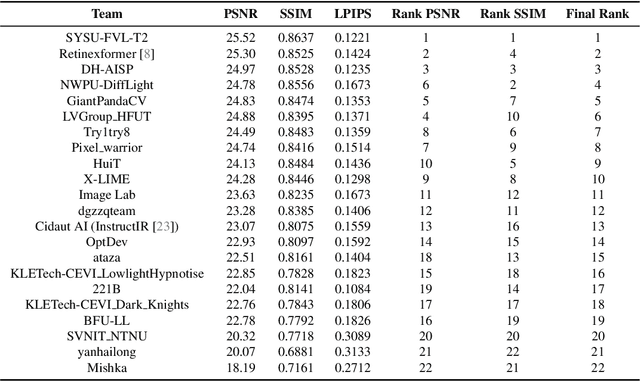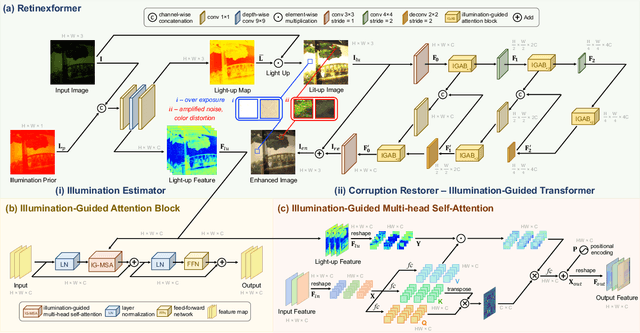Yan Luo
CurveFlow: Curvature-Guided Flow Matching for Image Generation
Aug 20, 2025Abstract:Existing rectified flow models are based on linear trajectories between data and noise distributions. This linearity enforces zero curvature, which can inadvertently force the image generation process through low-probability regions of the data manifold. A key question remains underexplored: how does the curvature of these trajectories correlate with the semantic alignment between generated images and their corresponding captions, i.e., instructional compliance? To address this, we introduce CurveFlow, a novel flow matching framework designed to learn smooth, non-linear trajectories by directly incorporating curvature guidance into the flow path. Our method features a robust curvature regularization technique that penalizes abrupt changes in the trajectory's intrinsic dynamics.Extensive experiments on MS COCO 2014 and 2017 demonstrate that CurveFlow achieves state-of-the-art performance in text-to-image generation, significantly outperforming both standard rectified flow variants and other non-linear baselines like Rectified Diffusion. The improvements are especially evident in semantic consistency metrics such as BLEU, METEOR, ROUGE, and CLAIR. This confirms that our curvature-aware modeling substantially enhances the model's ability to faithfully follow complex instructions while simultaneously maintaining high image quality. The code is made publicly available at https://github.com/Harvard-AI-and-Robotics-Lab/CurveFlow.
DA-Occ: Efficient 3D Voxel Occupancy Prediction via Directional 2D for Geometric Structure Preservation
Jul 31, 2025Abstract:Efficient and high-accuracy 3D occupancy prediction is crucial for ensuring the performance of autonomous driving (AD) systems. However, many current methods focus on high accuracy at the expense of real-time processing needs. To address this challenge of balancing accuracy and inference speed, we propose a directional pure 2D approach. Our method involves slicing 3D voxel features to preserve complete vertical geometric information. This strategy compensates for the loss of height cues in Bird's-Eye View (BEV) representations, thereby maintaining the integrity of the 3D geometric structure. By employing a directional attention mechanism, we efficiently extract geometric features from different orientations, striking a balance between accuracy and computational efficiency. Experimental results highlight the significant advantages of our approach for autonomous driving. On the Occ3D-nuScenes, the proposed method achieves an mIoU of 39.3% and an inference speed of 27.7 FPS, effectively balancing accuracy and efficiency. In simulations on edge devices, the inference speed reaches 14.8 FPS, further demonstrating the method's applicability for real-time deployment in resource-constrained environments.
NTIRE 2025 Image Shadow Removal Challenge Report
Jun 18, 2025Abstract:This work examines the findings of the NTIRE 2025 Shadow Removal Challenge. A total of 306 participants have registered, with 17 teams successfully submitting their solutions during the final evaluation phase. Following the last two editions, this challenge had two evaluation tracks: one focusing on reconstruction fidelity and the other on visual perception through a user study. Both tracks were evaluated with images from the WSRD+ dataset, simulating interactions between self- and cast-shadows with a large number of diverse objects, textures, and materials.
RD-UIE: Relation-Driven State Space Modeling for Underwater Image Enhancement
May 02, 2025



Abstract:Underwater image enhancement (UIE) is a critical preprocessing step for marine vision applications, where wavelength-dependent attenuation causes severe content degradation and color distortion. While recent state space models like Mamba show potential for long-range dependency modeling, their unfolding operations and fixed scan paths on 1D sequences fail to adapt to local object semantics and global relation modeling, limiting their efficacy in complex underwater environments. To address this, we enhance conventional Mamba with the sorting-based scanning mechanism that dynamically reorders scanning sequences based on statistical distribution of spatial correlation of all pixels. In this way, it encourages the network to prioritize the most informative components--structural and semantic features. Upon building this mechanism, we devise a Visually Self-adaptive State Block (VSSB) that harmonizes dynamic sorting of Mamba with input-dependent dynamic convolution, enabling coherent integration of global context and local relational cues. This exquisite design helps eliminate global focus bias, especially for widely distributed contents, which greatly weakens the statistical frequency. For robust feature extraction and refinement, we design a cross-feature bridge (CFB) to adaptively fuse multi-scale representations. These efforts compose the novel relation-driven Mamba framework for effective UIE (RD-UIE). Extensive experiments on underwater enhancement benchmarks demonstrate RD-UIE outperforms the state-of-the-art approach WMamba in both quantitative metrics and visual fidelity, averagely achieving 0.55 dB performance gain on the three benchmarks. Our code is available at https://github.com/kkoucy/RD-UIE/tree/main
An Experimental Study of Passive UAV Tracking with Digital Arrays and Cellular Downlink Signals
Dec 30, 2024Abstract:Given the prospects of the low-altitude economy (LAE) and the popularity of unmanned aerial vehicles (UAVs), there are increasing demands on monitoring flying objects at low altitude in wide urban areas. In this work, the widely deployed long-term evolution (LTE) base station (BS) is exploited to illuminate UAVs in bistatic trajectory tracking. Specifically, a passive sensing receiver with two digital antenna arrays is proposed and developed to capture both the line-of-sight (LoS) signal and the scattered signal off a target UAV. From their cross ambiguity function, the bistatic range, Doppler shift and angle-of-arrival (AoA) of the target UAV can be detected in a sequence of time slots. In order to address missed detections and false alarms of passive sensing, a multi-target tracking framework is adopted to track the trajectory of the target UAV. It is demonstrated by experiments that the proposed UAV tracking system can achieve a meter-level accuracy.
Impact of Data Distribution on Fairness Guarantees in Equitable Deep Learning
Dec 29, 2024



Abstract:We present a comprehensive theoretical framework analyzing the relationship between data distributions and fairness guarantees in equitable deep learning. Our work establishes novel theoretical bounds that explicitly account for data distribution heterogeneity across demographic groups, while introducing a formal analysis framework that minimizes expected loss differences across these groups. We derive comprehensive theoretical bounds for fairness errors and convergence rates, and characterize how distributional differences between groups affect the fundamental trade-off between fairness and accuracy. Through extensive experiments on diverse datasets, including FairVision (ophthalmology), CheXpert (chest X-rays), HAM10000 (dermatology), and FairFace (facial recognition), we validate our theoretical findings and demonstrate that differences in feature distributions across demographic groups significantly impact model fairness, with performance disparities particularly pronounced in racial categories. The theoretical bounds we derive crroborate these empirical observations, providing insights into the fundamental limits of achieving fairness in deep learning models when faced with heterogeneous data distributions. This work advances our understanding of fairness in AI-based diagnosis systems and provides a theoretical foundation for developing more equitable algorithms. The code for analysis is publicly available via \url{https://github.com/Harvard-Ophthalmology-AI-Lab/fairness_guarantees}.
FairDiffusion: Enhancing Equity in Latent Diffusion Models via Fair Bayesian Perturbation
Dec 29, 2024



Abstract:Recent progress in generative AI, especially diffusion models, has demonstrated significant utility in text-to-image synthesis. Particularly in healthcare, these models offer immense potential in generating synthetic datasets and training medical students. However, despite these strong performances, it remains uncertain if the image generation quality is consistent across different demographic subgroups. To address this critical concern, we present the first comprehensive study on the fairness of medical text-to-image diffusion models. Our extensive evaluations of the popular Stable Diffusion model reveal significant disparities across gender, race, and ethnicity. To mitigate these biases, we introduce FairDiffusion, an equity-aware latent diffusion model that enhances fairness in both image generation quality as well as the semantic correlation of clinical features. In addition, we also design and curate FairGenMed, the first dataset for studying the fairness of medical generative models. Complementing this effort, we further evaluate FairDiffusion on two widely-used external medical datasets: HAM10000 (dermatoscopic images) and CheXpert (chest X-rays) to demonstrate FairDiffusion's effectiveness in addressing fairness concerns across diverse medical imaging modalities. Together, FairDiffusion and FairGenMed significantly advance research in fair generative learning, promoting equitable benefits of generative AI in healthcare.
TransFair: Transferring Fairness from Ocular Disease Classification to Progression Prediction
Dec 03, 2024



Abstract:The use of artificial intelligence (AI) in automated disease classification significantly reduces healthcare costs and improves the accessibility of services. However, this transformation has given rise to concerns about the fairness of AI, which disproportionately affects certain groups, particularly patients from underprivileged populations. Recently, a number of methods and large-scale datasets have been proposed to address group performance disparities. Although these methods have shown effectiveness in disease classification tasks, they may fall short in ensuring fair prediction of disease progression, mainly because of limited longitudinal data with diverse demographics available for training a robust and equitable prediction model. In this paper, we introduce TransFair to enhance demographic fairness in progression prediction for ocular diseases. TransFair aims to transfer a fairness-enhanced disease classification model to the task of progression prediction with fairness preserved. Specifically, we train a fair EfficientNet, termed FairEN, equipped with a fairness-aware attention mechanism using extensive data for ocular disease classification. Subsequently, this fair classification model is adapted to a fair progression prediction model through knowledge distillation, which aims to minimize the latent feature distances between the classification and progression prediction models. We evaluate FairEN and TransFair for fairness-enhanced ocular disease classification and progression prediction using both two-dimensional (2D) and 3D retinal images. Extensive experiments and comparisons with models with and without considering fairness learning show that TransFair effectively enhances demographic equity in predicting ocular disease progression.
FairDomain: Achieving Fairness in Cross-Domain Medical Image Segmentation and Classification
Jul 11, 2024Abstract:Addressing fairness in artificial intelligence (AI), particularly in medical AI, is crucial for ensuring equitable healthcare outcomes. Recent efforts to enhance fairness have introduced new methodologies and datasets in medical AI. However, the fairness issue under the setting of domain transfer is almost unexplored, while it is common that clinics rely on different imaging technologies (e.g., different retinal imaging modalities) for patient diagnosis. This paper presents FairDomain, a pioneering systemic study into algorithmic fairness under domain shifts, employing state-of-the-art domain adaptation (DA) and generalization (DG) algorithms for both medical segmentation and classification tasks to understand how biases are transferred between different domains. We also introduce a novel plug-and-play fair identity attention (FIA) module that adapts to various DA and DG algorithms to improve fairness by using self-attention to adjust feature importance based on demographic attributes. Additionally, we curate the first fairness-focused dataset with two paired imaging modalities for the same patient cohort on medical segmentation and classification tasks, to rigorously assess fairness in domain-shift scenarios. Excluding the confounding impact of demographic distribution variation between source and target domains will allow clearer quantification of the performance of domain transfer models. Our extensive evaluations reveal that the proposed FIA significantly enhances both model performance accounted for fairness across all domain shift settings (i.e., DA and DG) with respect to different demographics, which outperforms existing methods on both segmentation and classification. The code and data can be accessed at https://ophai.hms.harvard.edu/datasets/harvard-fairdomain20k.
NTIRE 2024 Challenge on Low Light Image Enhancement: Methods and Results
Apr 22, 2024



Abstract:This paper reviews the NTIRE 2024 low light image enhancement challenge, highlighting the proposed solutions and results. The aim of this challenge is to discover an effective network design or solution capable of generating brighter, clearer, and visually appealing results when dealing with a variety of conditions, including ultra-high resolution (4K and beyond), non-uniform illumination, backlighting, extreme darkness, and night scenes. A notable total of 428 participants registered for the challenge, with 22 teams ultimately making valid submissions. This paper meticulously evaluates the state-of-the-art advancements in enhancing low-light images, reflecting the significant progress and creativity in this field.
 Add to Chrome
Add to Chrome Add to Firefox
Add to Firefox Add to Edge
Add to Edge